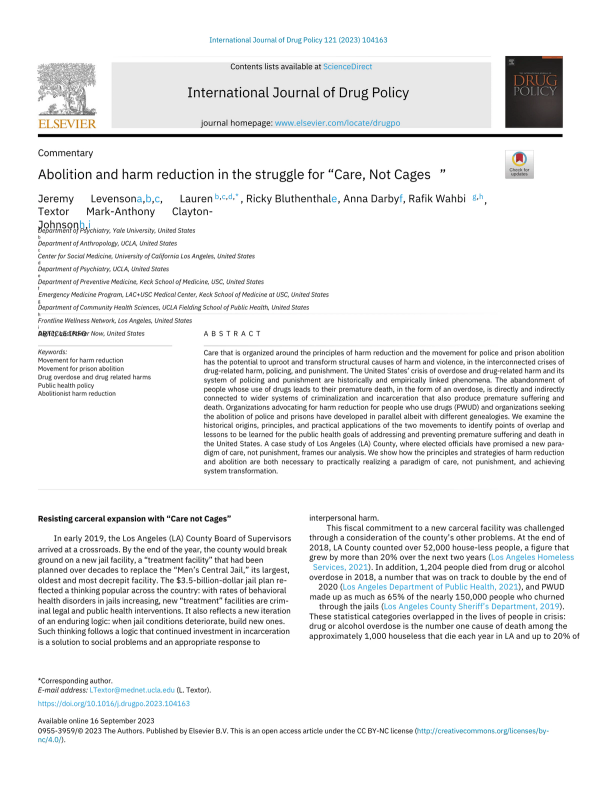Abolition and harm reduction in the struggle for “Care, Not Cages”
Abstract
Care that is organized around the principles of harm reduction and the movement for police and prison abolition has the potential to uproot and transform structural causes of harm and violence, in the interconnected crises of drug-related harm, policing, and punishment. The United States’ crisis of overdose and drug-related harm and its system of policing and punishment are historically and empirically linked phenomena. The abandonment of people whose use of drugs leads to their premature death, in the form of an overdose, is directly and indirectly connected to wider systems of criminalization and incarceration that also produce premature suffering and death. Organizations advocating for harm reduction for people who use drugs (PWUD) and organizations seeking the abolition of police and prisons have developed in parallel albeit with different genealogies. We examine the historical origins, principles, and practical applications of the two movements to identify points of overlap and lessons to be learned for the public health goals of addressing and preventing premature suffering and death in the United States. A case study of Los Angeles (LA) County, where elected officials have promised a new paradigm of care, not punishment, frames our analysis. We show how the principles and strategies of harm reduction and abolition are both necessary to practically realizing a paradigm of care, not punishment, and achieving system transformation.
Resisting carceral expansion with “Care not Cages”
In early 2019, the Los Angeles (LA) County Board of Supervisors arrived at a crossroads. By the end of the year, the county would break ground on a new jail facility, a “treatment facility” that had been planned over decades to replace the “Men's Central Jail,” its largest, oldest and most decrepit facility. The $3.5-billion-dollar jail plan reflected a thinking popular across the country: with rates of behavioral health disorders in jails increasing, new “treatment” facilities are criminal legal and public health interventions. It also reflects a new iteration of an enduring logic: when jail conditions deteriorate, build new ones. Such thinking follows a logic that continued investment in incarceration is a solution to social problems and an appropriate response to interpersonal harm.
This fiscal commitment to a new carceral facility was challenged through a consideration of the county's other problems. At the end of 2018, LA County counted over 52,000 house-less people, a figure that grew by more than 20% over the next two years (Los Angeles Homeless Services, 2021). In addition, 1,204 people died from drug or alcohol overdose in 2018, a number that was on track to double by the end of 2020 (Los Angeles Department of Public Health, 2021), and PWUD made up as much as 65% of the nearly 150,000 people who churned through the jails (Los Angeles County Sheriff's Department, 2019). These statistical categories overlapped in the lives of people in crisis: drug or alcohol overdose is the number one cause of death among the approximately 1,000 houseless that die each year in LA and up to 20% of those people had been incarcerated in the two years prior to their death (Los Angeles Department of Public Health, 2020).
